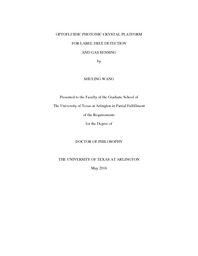
ATTENTION: The works hosted here are being migrated to a new repository that will consolidate resources, improve discoverability, and better show UTA's research impact on the global community. We will update authors as the migration progresses. Please see MavMatrix for more information.
Show simple item record
| dc.contributor.advisor | Sun, Yuze | |
| dc.creator | Wang, Shuling | |
| dc.date.accessioned | 2017-09-13T14:27:21Z | |
| dc.date.available | 2017-09-13T14:27:21Z | |
| dc.date.created | 2016-05 | |
| dc.date.issued | 2016-05-10 | |
| dc.date.submitted | May 2016 | |
| dc.identifier.uri | http://hdl.handle.net/10106/26918 | |
| dc.description.abstract | Photonic crystals (PhCs) based label-free sensing technology has great potential as a highly sensitive, high-throughput, and compact that has vast applications in biomedical research, healthcare, pharmaceuticals, environmental security, and battlefield to detect target analytes in either liquid or vapor phase. The PhC refers to a heterogeneous structure composed of a periodic arrangement of low-loss dielectric materials with contrasting refractive index (RI). Such a structure constrains the light propagation in certain ways such that the optical properties of the PhC are particularly sensitive to changes in RI, which in turn makes them useful for sensing purposes, since the interaction of target analytes with light causes the change of local RI.
Most of the studies reported so far involved micro-cavities into PhCs to achieve high quality factor, and hence better sensing performance. The in-plane light coupling method associated with micro-cavities increased the alignment challenge and made it difficult for system miniaturization. To meet this challenge, two-dimensional (2D) photonic crystal slab (PCS) is studied in this dissertation. In 2D PCS, light can be confined to in-plane guided modes by the higher RI dielectric material without coupling to externally incident beam, or can be confined to guided resonance modes in the slab where coupling to externally incident beam is allowed. Fano resonance in 2D PCS arises from the coupling of in-plane guided resonance modes above the light line to the out-of-the-plane radiation modes due to phase-matching provided by the periodic lattice structure. It is promising to employ Fano resonance in 2D PCS for sensing applications, since it provides an efficient way to channel light from within the slab to the external environment. Furthermore, Fano resonance results in asymmetric Fano lineshape in the reflection and transmission spectrum, featuring a sharp peak-to-dip transition in contrast to the conventional symmetric Lorentzian lineshape in other resonance sensors. This sharp transition in Fano lineshape is advantageous for extracting small spectral shift induced from small RI change, hence, more sensitive detection can be achieved.
For bulk liquid sensing, both single-layer and coupled double-layer PCS are simulated using Fourier modal method (FMM) and finite-difference time-domain (FDTD) method, which provides guidelines for future sensor design. And then the optofluidic sensing platform based on both single-layer and coupled double-layer PCS is built and the sensor performance is characterized with various concentrations of ethanol/deionized water mixture using surface normal measurement system.
In the chemical vapor detection, PCS vapor sensing platform is developed by coating vapor sensitive polymer onto PCS surface. The interaction between polymer and vapor analytes results in the polymer thickness and/or RI change, which leads to Fano resonance spectral shift. The capability of vapor sensing is demonstrated with representative vapor analytes, and the detection specificity is realized by coating PCS with different vapor absorbing polymers. Moreover, theoretical analysis using FMM and FDTD method is performed which gives guidelines to optimize the future designs of the PCS based vapor sensor. | |
| dc.format.mimetype | application/pdf | |
| dc.language.iso | en_US | |
| dc.subject | Fano resonance | |
| dc.subject | Photonic crystal slab | |
| dc.subject | Optical sensing | |
| dc.subject | Label-free detection | |
| dc.subject | Gas sensing | |
| dc.title | OPTOFLUIDIC PHOTONIC CRYSTAL PLATFORM FOR LABEL-FREE DETECTION AND GAS SENSING | |
| dc.type | Thesis | |
| dc.contributor.committeeMember | Sun, Yuze | |
| dc.degree.department | Electrical Engineering | |
| dc.degree.name | Doctor of Philosophy in Electrical Engineering | |
| dc.date.updated | 2017-09-13T14:27:21Z | |
| thesis.degree.department | Electrical Engineering | |
| thesis.degree.grantor | The University of Texas at Arlington | |
| thesis.degree.level | Doctoral | |
| thesis.degree.name | Doctor of Philosophy in Electrical Engineering | |
| dc.type.material | text | |
Files in this item
- Name:
- WANG-DISSERTATION-2016.pdf
- Size:
- 3.795Mb
- Format:
- PDF
This item appears in the following Collection(s)
Show simple item record


